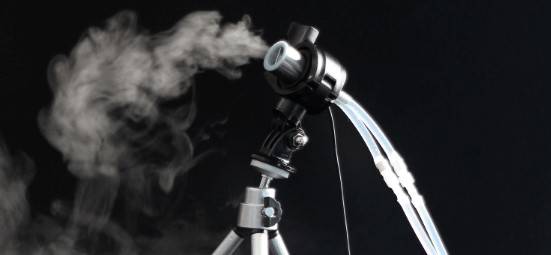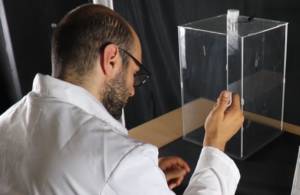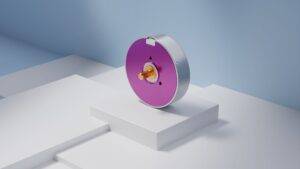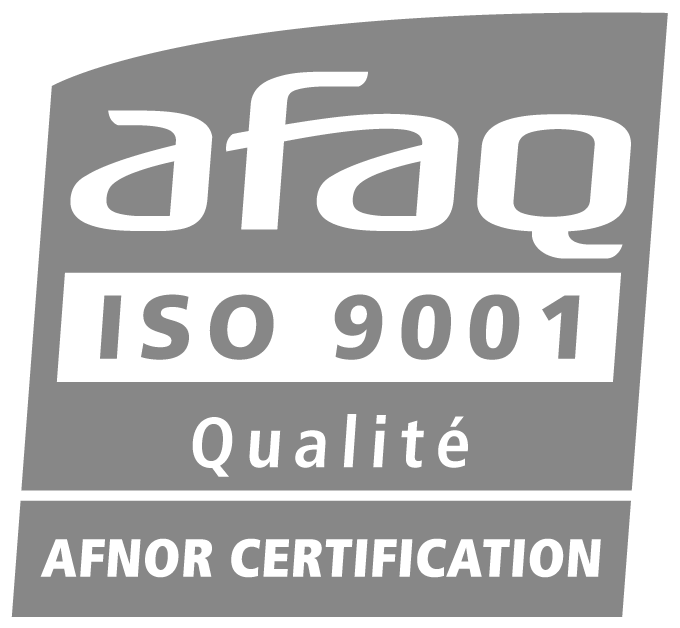Tekceleo’s Micronice® technology, a technological breakthrough over standard ultrasonic nebulization
1. Tekceleo Micronice® nebulizers: an advanced vibrating mesh technology
Vibrating mesh atomization uses a simple principle: the surface tension of a liquid causes it to be “extruded” into a cloud of droplets when it comes in contact with a vibrating microperforated membrane (or “mesh”).
Thus, it is the vibration of the membrane on the surface of the liquid that produces droplets. As a result, the droplet size depends directly on the diameter of the microperforated holes. The generation of the aerosol is made in a calibrated way, which allows a “monodispersed” nebulization.
Consequently, for a vibrating membrane atomization the aerosol is not generated by a liquid projection, by pressure, speed increase or by heating. Hence, the liquid is absolutely not altered nor heated in the process. That’s because the atomization happens only by an ultrasonic vibration of the membrane (vibratory frequency above the audible frequencies for human being, that is above 40 kHz). Moreover, the generated aerosol is sprayed with very little inertia (output speed is almost zero).
2. Micronice’s unique feature : a metal transducer which increase performances, ease of use and lifespan of the device
The vibrating mesh nebulization technology is used by several of industrials familiar with the piezoelectric effect. Indeed, it is the electrical stimulation of a piezoelectric ceramic ring that causes a membrane to vibrate at ultrasonic frequencies.
Vibrating mesh nebulizer (or just “mesh nebulizer”) are particularly widespread in aerosol therapy, due to its main strength :
- No alteration of the liquid (and therefore of its active ingredient)
- Ability to generate very fine monodispersed aerosols (4 microns)
- Ability to nebulize suspensions
- Output speed is almost zero
- Very low power consumption, which allows the creation of portable “hand-held” devices
Nevertheless, most of current manufacturers’ design has some weaknesses: the piezoelectric ceramic supplied with high voltage, active part of the device, is directly in contact, or must be very close, to the nebulized liquid. Thus, if this liquid is corrosive, heated or simply if the duration of use exceeds a certain limit the product stops working. As a result, this type of design leads to lifetimes in line with “consumer market” or disposable medical applications but is limited for professional and industrial applications.
Micronice® technology differs from its competitors by a patented innovation that transforms a metal body into an amplified piezoelectric transducer, which in turn vibrates a microperforated membrane. Such an amplified transducer improves both the robustness of the device (the active parts are isolated from the liquid) and the vibratory speed of the membrane, allowing a better flow rate related to the size of the device.
Moreover, our technology, by making the electronic part of the device more reliable, allows a very simple and precise control of the flow, to the nearest microliter.
3. Where to start with all the different technologies known as ” ultrasonic ” today ?
Currently, many technologies are used for aerosol generation:
- Pressure-based technology :
- High pressure liquid generator (sprayer)
- Pneumatic generator (Venturi effect)
- Compressed/pressurized/liquified gas generator
- Technology using ultrasonic vibrations (piezoelectric) :
- High frequency ultrasonic atomization
- Vibrating mesh technology
- Vaporization technology
Each of these technologies relies on different physical properties, which result on pros and con for different markets and use cases.
One of the most common problem is that often the term “ultrasonic” nebulizer, “ultrasonic” humidifier or “ultrasonic” aerosol generator does not clearly identify the principle and the technology used. This makes it difficult to compare the different products on the market, especially since the two ultrasonic technologies (high frequency atomization and vibrating mesh atomization) are very different when using the piezoelectric effect. This is why we will compare the two ultrasonic technologies in this article:
- On one hand, « high frequency ultrasonic atomization » (1,6 MHz), commonly used for humidification.
- On the other hand, vibration mesh technology, specifically the Micronice® technology (85 kHz).
A comparison of common ultrasonic nebulization technologies versus Micronice® technology
1. Differences in the operating principle
The main difference between high frequency ultrasonic atomizer and vibrating mesh nebulizer is the operating principle, which relies on a very different way to use the piezo vibrations :
- For high frequency ultrasonic technology, the transducer is materialized by a « tablet » directly immersed into a liquid tank. It’s the vibration of this tablet (by piezo effect) at a very high frequency (near 1,6 MHz) that will create acoustic waves. The propagation of these waves inside the liquid create an « acoustic jet » phenomenom. As a result, the liquid at the surface is atomized. However, the very high frequency of vibration of the immersed piezo actuator (the « tablet ») is resulting in heating of the liquid. Moreover, this active part of the system must be constantly immerged in the liquid or it will break (quick heating and friction), which implies a consequent dead volume.
- In the Micronice® technology, the transducer vibrates at a frequency of 85 kHz by being coupled to the natural vibration mode of a microperforated membrane. It is the vibration of the membrane itself on the liquid that leads to the formation of an aerosol. As a result, the liquid is isolated from the active part (piezo actuator).
Therefore, the vibration modes of these two ultrasonic technologies are different :
- For the Micronice® vibrating mesh technology, it’s the membrane itself that mechanically extrude the liquid into an aerosol. Whereas for ultrasonic high frequency nebulizer it’s the liquid itself that is “fractioned” by the energy of the generated acoustic waves.
- Therefore, the vibration modes not of the same intensity : high frequency atomization requires a frequency 20 times higher than Micronice® !
- The impact is substantial : high frequency ultrasonic nebulizers requires a much higher power (on average 64W), while Micronice® vibrating mesh technology is very power effective (3W). Which also implies a rapid heating of the liquid for high frequency technology. By comparison, vibrating mesh technology does not heat or altered the liquid in any way.
2. Simplicity of use
There is another field where the difference is substantial : simplicity of use. Indeed, conventional ultrasonic technologies are based on a high power principle, coupled with an immersion of the actuator. As a result, this limit their possibilities in terms of integration or use cases :
- It’s difficult to generate low and precise flowrate (micro-volume aerosol generation). Mostly because the atomization principle is based on power and requires to reach a « threshold » to operate.
- By design, this technology implies to centralize the liquid in a tank, where it can be atomized. The generated aerosol is produced at the surface of the liquid in this tank and must be transported by a ventilation system. This particularity implies a significant footprint and to operate and maintain a whole ventilation and fluidic system.
- Complexity of control, due to the inertia of the system. Even if the nebulization process is stopped, the generated aerosol will have built up in the reservoir.
- Liquid heating in the reservoir implies a severe contamination control, which implies at least a purging function and a frequent disinfection of the system.
- A liquid detection system must be implemented, because the transducer is immediately (<1ms) destroyed if it’s no longer immersed (ultra-fast heating of the material).
Nevetheless, high frequency ultrasonic technology has advantages when it comes to produce a large quantity of fine aerosol continuously. In this case, it allows to generate a continuous monodispered aerosol in an economic way (mostly due to its generalization and mass production for every-day humidification uses).
Im comparison, for Micronice® technolgy, simplicity of use is at the core of the design:
- Electronic control of the flowrate is native for our solution. The vibration of the membrane can be controlled in ON/OFF mode, with a response time of less than a millisecond.
- Micronice technology is a decentralized system, the aerosol is generated at the exit of the nozzle and liquid can just « circulate », which allows a use without a tank of stagnant liquid. It also permits to directly integrate the technology on a device of equipment, without designing
- “Plug and Play » device, nozzle can be integrated and piloted in any device. Flowrate and operation is easily controlled by PWM.
3. Performances
In terms of performances, several parameters can be considered :
- Energy performance
- Flow rate
- Aerosol quality
Comparison is made between two identical devices for each technology (Micronice vs. Standard ultrasonic humidifier). Regarding performances, the two compared technologies appeared quite different :
- Energy performance :
- High frequency ultrasonic nebulizer : 62W for one nozzle
- Vibrating Mesh Micronice® : 3W for one nozzle
- Flowrate :
- High frequency ultrasonic nebulizer : 0,5 L/h (8 ml/min) for one nozzle (droplet size centered on 8 µm). Footprint of the device : 133x160x235cm.
- Micronice® : Will depend on the droplet size. For equivalent flowrate of 0,5 L/h for one nozzle, the droplet size will be 20 µm. Footprint of the device (with fully functional fluidic system with pump, tubes and reservoir) : 35x42x7cm. Footprint of one nozzle : 20x46mm. The flowrate to size ratio is highly favorable to the Micronice technology.
- Micronice® technology, thanks to its low footprint and power consumption, allows to easily use several nozzles in series. That permits to design configurations with very high flow rate as well as very low flowrate. Indeed, its main strength is its scalability. Nevertheless, with a vibrating mesh technology, the droplet size will directly influence the maximum flow rate achievable per nozzle :
- 04 µm: 1,2 ml/mn
- 10 µm: 2ml/min
- 15 µm: 3,5 ml/min
- 20 µm: 8 ml/min
- 50 µm: 40 ml/min
- Aerosol Quality :
- High frequency ultrasonic nebulizer : monodispersed aerosol with a droplet size centered on 8 µm. No easy option to modulate the droplet size. Moreover, liquid is altered by the heating effect of the immersed piezo actuator (up to 45°C).
- Vibrating mesh technology Micronice® : droplet size depends on the size of the holes of the micro-perforated membrane. Therefore, a wide range of aerosols is possible, while remaining monodispersed and without altering, pressuring nor heating.
4. Control
Main advantage of ultrasonic spray technologies is the native electronic control. This feature facilitates their integration into more complex system, e.g. via industrial controllers. In our comparison we will look at the range of controllable parameters for our two different ultrasonic spray technologies :
- High frequency ultrasonic sprayer :
- ON/OFF control, low latency of the electronics, but several seconds reaction time related to the acoustic jet. The latency is directly related to the aerosol generation principle of this technology (acoustic jet). This kind of control is not precise enough for microvolumes generatio. In addition, flow rate can vary according to the quantity of liquid and its temperature, resulting in a non-linear flowrate over time.
- This kind of technology exploits a non-linear effect : threshold or plateau. Therefore, it is difficult to modulate or to control precisely the flowrate.
- Vibrating Mesh Micronice®:
- Very low latency electronic control (<1ms). Mechanical reaction time of the membrane is <10 ms, with no inertia.
- ON/OFF Control, but also possibility to modulate the flowrate via PWM. Flowrate modulation is linear and can be done in very precise increments (1%).
Native electronic control is a generic advantage of ultrasonic nebulization technologies over other technologies (pressurized, pneumatic, etc.). Among the ultrasonic nebulizer range, Micronice® technology distinguished itself even more by allowing a very low latency and an extremely precise flowrate control. Thus opening the way to very high precision applications (laboratory research, controlled environments, etc.).
5. Reliability and durability
Reliabilty and lifespan of a nebulizer are not necesarily key factor for some applications (aerosoltherapy for example). But, in some industries it is a prerequisite to have a reliable nebulization fonction, such as the food industry or industrial humidification. In these industries an operating problem on the nebulizer/humidifier can result on high scale loss of value.
- High frequency ultrasonic sprayer :
- Good reliability within a framework of controlled use and with followed maintenance. The liquid proximity with the electronics parts requires regular maintenance checks. Moreover, the active part of the nebulizer must stay immersed or it will break, that requires to have a secured and constant input of liquid. Without further issue, the average lifespan of such a device is 5000 hours (with water).
- High power and electrical consumption induce a complexity and vulnerability concerning electronic parts of the device. It implies regular maintenance or spare parts over long periods of use.
- Vibrating Mesh Micronice®:
- Isolating the active part from the liquid ensures a very long lifespan of the device, of more than 20 000 hours of operation with water. The device is also resistant to corrosive liquids, both acidic and basic (with stainless steel model).
- Very low power requirement result in very robust electronics that can operate continuously for thousands of hours without overheating or wear.
- One of the possible disadvantages is the potential clogging of the membrane, which implies having a cleaning cycle when the liquid involved may generate deposits. For example, treatments may be necessary for very calcareous water (filter, additives…).
6. Price
At the moment of writing this article, price is one of the distinguishing factors between the two compared technologies, as they do not have the same cost structure and market maturity :
- High frequency ultrasonic nebulizers are at lower cost when compared to flowrate. This makes it mor attractive for non-complex humidification applications, for example. However, this lower purchasing cost has to be put into perspective with the maintenance that such a device implies:
- Upkeep maintenance cost, particularly in terms of contamination control (liquid tank stagnating at around 40-50°C).
- Curative maintenance linked to the life span of the active immersed equipement and electronic parts.
- Power consumption cost over the time of operation.
- The vibrating mesh Micronice technology is currently more expensive in nominal cost, due to a less volume-oriented production, but is more reliable, which represents a sustainable investment logic:
- Very low power consumption.
- Very low chance of electronic or transducer failure over time.
- Very long operation time without maintenance (“set and forget” logic).
- Can be used with corrosive liquids (disinfection, research, surface deposits…), for the stainless steel design.
Conclusion : Micronice®, allowing to broaden and improve the advantages of ultrasonic nebulization
This comparison allows to appreciate that the Micronice® vibrating mesh technology is an improvement of the classical ultrasonic nebulization principle. By vibrating a metal body, coupled with the mode of a microperforated membrane, the vibration effect is amplified and allows to use less power and make the device more robust.
The fact that the membrane defines the flow rate and drop size also makes this technology more adaptable. It is then a simple matter to adapt the membrane, which is a passive part, rather than changing the whole device. Thus, the Micronice® technology stands out for the following reasons:
- Reliability and very low maintenance cost.
- Simplicity and modularity.
- A unique variety of different droplet sizes possible with the same system (only the nozzle changes), ranging from 4 microns to 50 microns.
- Very low operational constraints: compact (20mmx46mm), low power consumption (<3W) and inaudible (<35db).




